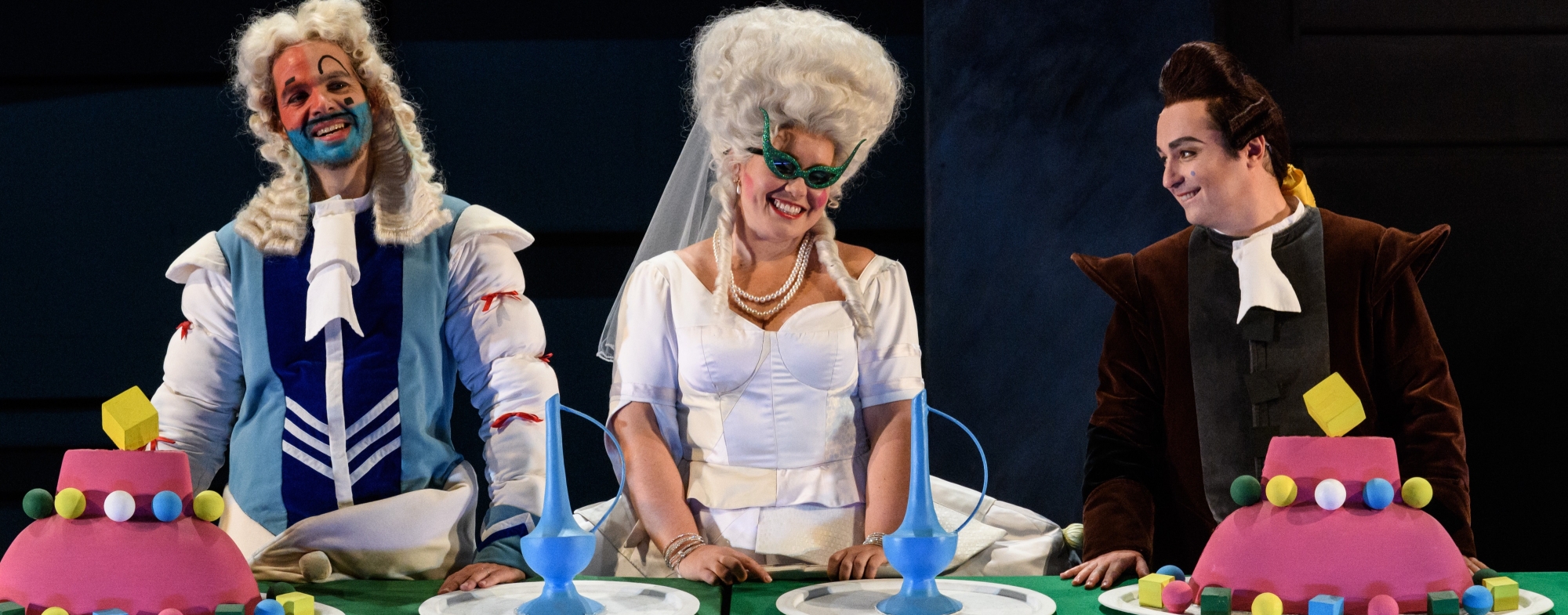

La Cenerentola Rossini's Cinderella
Archived: 2018/2019Overview
Rossini’s delightful retelling of Cinderella is a candy-coloured world of fairy tale, full of wit, larger than life characters and vibrant costumes
Rossini’s delightful retelling of Cinderella but with a few twists along the way.
The kind-hearted Angelina (Cinderella) is forced to scrub the floors by her wicked stepfather, while her ugly sisters prepare to go to the Prince’s grand ball at the palace. As she dreams of a better life she is visited by a mysterious old beggar man. He tells her she will go to the ball, and will also be rewarded for her kind heart. Will she live happily ever after?
WNO transports you into a candy-coloured world of fairy tale full of wit, larger than life characters, delightful mice and vibrant costumes. Tomáš Hanus conducts Rossini’s sparkling score, as we watch La Cenerentola transform from rags to riches through the power of music.
The StageXevi Dorca’s colourful revival admirably blends wit and warmth... Tara Erraught’s Angelina proves a spirited heroine
The Reviews HubRossini’s virtuosic music is played with precision and verve... the cast are uniformly strong throughout




Good to know
Italian with surtitles in English (and Welsh in Cardiff and Llandudno)
Co-production with Houston Grand Opera, Grand Teatre del Liceu & Grand Théâtre de Genéve
Facts
The earliest Cinderella story in print is Giambattista Basile's Pentamerone of 1634 where Cenerentola first appears, but it was Charles Perrault's version Cendrillon written in 1697 that introduces details now intrinsically associated with the story - most notable the pumpkin, the fairy godmother and the glass slipper.
Born in the Papal States in 1792 Rossini was known as the Swan of Pesaro. He is considered to be one of the most popular composers of the first half of the 19th century and his ornate musical style revolutionised the art form, especially in the opera buffa (comic opera) style, inaugurating the Golden Century of Italian opera.
When asked for the musical preferences Rossini declared 'I take Beethoven twice a week, Haydn four times but Mozart every day - Mozart is always adorable!'
Synopsis
In a hall in Don Magnifico’s castle, his daughters Clorinda and Tisbe are titivating themselves, while their stepsister Cenerentola (Cinderella), whose real name is Angelina, sings a song about a king who chose a good-natured girl as his bride. She gives breakfast to a beggar (Alidoro, Prince Ramiro’s tutor in disguise) to her sisters’ annoyance. The prince’s knightly retinue announce that the prince is about to give a grand ball at which he will choose the most beautiful woman as his wife. The beggar prophesies that tomorrow Cenerentola will be happy. Don Magnifico wakes up and describes a dream he has had, predicting that he will gain a great fortune. When he hears of the prince’s visit, he is convinced that one of his daughters will win his hand. Ramiro swaps clothes with his attendant, Dandini, and makes a visit in disguise. He and Cenerentola fall in love at first sight. Clorinda and Tisbe are introduced to Dandini, playing the prince. Cenerentola asks to go to the ball but Don Magnifico tells her to stay at home. When Alidoro brings a list of unmarried women, and asks where Magnifico’s third daughter is Magnifico tells him she has died. Alidoro secretly tells Cenerentola who he is, and invites her to the ball. At the palace, Dandini (still in disguise) makes Magnifico his wine steward. Clorinda and Tisbe are rude to Ramiro, thinking him to be nothing but an attendant. A beautiful, mysterious lady appears and the step-sisters are astonished by how much she resembles Cenerentola.
INTERVAL
The courtiers laugh at the sisters. Magnifico thinks how much money he will make as the prince’s father-in-law. Ramiro overhears Cenerentola refusing Dandini’s courtship because she is in love with his attendant. She gives Ramiro a bracelet, and tells him he will recognise her because she will be wearing its twin. If he still loves her, he can marry her. Ramiro changes out of his disguise, and decides to track down the mysterious woman. Dandini lets Magnifico daydream then reveals who he really is. On their return to Magnifico’s castle the sisters find Cenerentola by the fire. They scold her for daring to look like the lady at the ball. Alidoro makes sure the prince’s carriage overturns outside the castle. Cenerentola and Alidoro recognise each other and everyone is astonished at the intricate tangle of events. Ramiro spirits Cenerentola away to his palace and Alidoro warns the sisters to beg for forgiveness. At the wedding, Cenerentola pleads with the prince to have mercy on her father and her stepsisters and reflects on how her own fortunes have changed.



